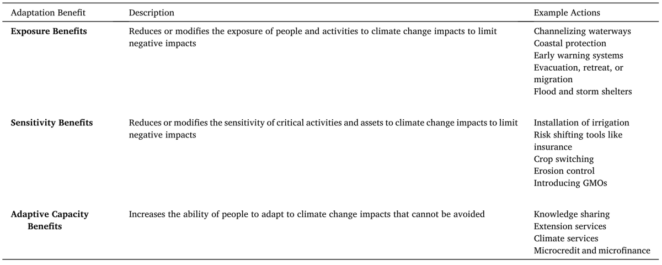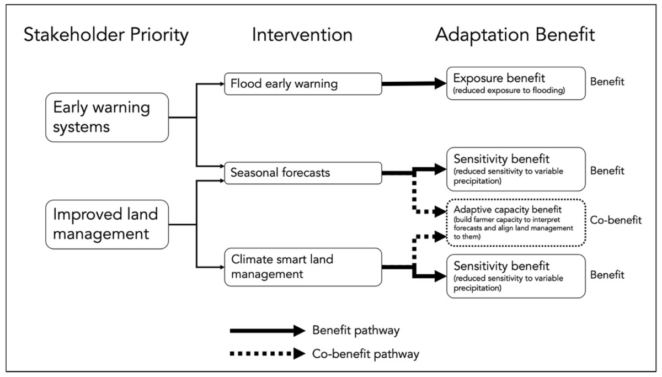Adaptation rationales and benefits: A foundation for understanding adaptation impact

Introduction
Efforts to achieve coordinated, effective, and impactful adaptation outcomes are complicated by factors ranging from the local specificity of adaptation needs to the challenges of politics and prioritization that drive funding decisions. However, impact pathways, which connect policy priorities to specific actions to their intended outcomes, are often poorly constructed. We call these impact pathways adaptation rationales, as they represent the logic of an adaptation action. The implicit nature of most current adaptation rationales makes it difficult to identify and test the accuracy and veracity of claims and assumptions underlying everything from policy priorities to intervention selection.
In this article:
- We address this foundational challenge for the adaptation community of practice by proposing a typology of adaptation benefits (reduced exposure, reduced sensitivity, and increased adaptive capacity) that facilitates the construction of meaningful, transparent adaptation rationales.
- We lay out what these well-understood components of vulnerability mean in the context of adaptation benefits and provide guiding questions for their use in constructing adaptation rationales.
- Using hypothetical and real-world examples of projects and portfolios, we illustrate how this typology and the adaptation rationales it enables focus attention on the goals of a given action, its likely effectiveness, and for whom it is likely to be effective.
Each of these issues offers an opportunity to strengthen project design, implementation, monitoring, and evaluation, while also facilitating portfolio-level understandings of adaptation approaches, assumptions, and efficacy.
This article is an abridged version of the original text “Adaptation rationales and benefits: A foundations for understanding adaptation impact” published in Climate Risk Management, 39, under the CC BY-NC-ND 4.0license in January 2023 © Carr and Nalau.Published by Elsevier B.V. Please note that references have been removed. For more detail, full references, and to quote text please use the paper available for download on the right.
Classifying Adaptation Benefits
In this section, we lay out the three categories of adaptation benefits in the proposed typology:
1. Exposure benefits = An intervention provides an exposure benefit if it lowers the frequency and/or magnitude of impacts on a person, population, or system targeted by the project. For example:
- An infrastructure investment moves a transportation corridor further from the coast to avoid existing or projected flooding
When considering if an adaptation action provides an exposure benefit, a guiding question is “does this action reduce the frequency and/or magnitude of one or more climate impacts on the person, population, activity, or resource targeted by the project?” Actions for which the answer is yes provide an exposure benefit.
2. Sensitivity benefits = An intervention provides a sensitivity benefit if it reduces the impact of a climate-related event on a person, population, or system – that is, the event still occurs with the same/greater frequency and magnitude, but the person, population, or system is not as affected by the event as before the intervention. For example:
- An infrastructure investment builds a roadway out of more durable, permeable materials to allow increasingly-frequent floodwaters to pass and recede quickly with minimal damage.
When considering if an adaptation action provides a sensitivity benefit, a guiding question is “if the person, population, or system targeted by the project cannot reduce exposure to a climate impact, does this action make those climate impacts less problematic?” Actions for which the answer is yes provide a sensitivity benefit.
3. Adaptive capacity benefits = An intervention provides an adaptive capacity benefit if it increases the ability of a person, population, or system to manage climate impacts or realize an opportunity emerging from climate change, including by transforming how and where they live. This can happen even if that population, person, or resource remains exposed to and very sensitive to a climate impact, though typically increasing adaptive capacity facilitates productive efforts to lower exposure and sensitivity. For example:
- Investment in local planning capacity can yield improved zoning and land management in urban areas, allowing municipalities to avert impacts like flooding by reducing the land use driver of this challenge. Here, the investment in improved planning is an adaptive capacity benefit, which yields an exposure benefit by improving the quality of zoning and land management to reduce flooding.
When considering if an action provides an adaptive capacity benefit, a guiding question is “does this action increase the ability of people to identify challenges and opportunities created by climate variability and change in a manner that allows them to address those challenges and mobilize those opportunities?” If the answer is yes, the action provides an adaptive capacity benefit.

To explore the adaptation benefits in more detail refer to pages 2-4 of the journal paper.
Constructing Adaptation Rationales
The construction of an adaptation rationale requires connecting adaptation goals to specific actions, and then linking those actions to expected adaptation benefits. Generally speaking, adaptation goals are best identified through processes that allow the widest possible range of stakeholders to bring forward both climate-related challenges and opportunities to address them.
To demonstrate this process, consider a hypothetical adaptation project in a semiarid agrarian region. Figure 1 illustrates this intervention’s adaptation rationales, connecting stakeholder priorities to particular interventions which are intended to produce specific adaptation benefits:
- The priority for early warning systems to protect the population from climate shocks and stresses is materialized in flood early warning systems, which are intended to provide an exposure benefit.
- However, this priority, when combined with the prioritization of improved land management, is also materialized in improved seasonal forecasts that can among other things, inform land and soil management practices. These forecasts are intended to deliver a sensitivity benefit, but there is an implied adaptive capacity co-benefit.
- Finally, the improved land management priority is materialized in the introduction of climate smart land management practices which deliver a sensitivity benefit, but also have an implied adaptive capacity service.

Learn more about constructing adaptation rationales on pages 4-5, and also about how to apply this framework beyond the project level through an example of the Least Developed Countries Fund project portfolio (p. 5-7).
Towards the Future
Adaptation rationales are critical tools for achieving adaptation benefits and shaping the design, planning and implementation of adaptation actions. Such rationales, however, require a foundational typology of adaptation benefits that also unpack the underlying assumptions and questions to be asked. This paper has proposed such a typology, drawing on well-understood concepts of exposure, sensitivity, and adaptive capacity.
The typology does not prescribe what the correct composition of an effective project looks like in terms of adaptation benefits, as this will vary depending on the context. Further, it makes no claims about the appropriate composition of a national portfolio (again, due to local specificity) or institutional portfolio. Instead, it enables the construction of effective, transparent adaptation rationales that are relevant to the design, implementation, monitoring, and evaluation of adaptation actions.
Adaptation rationales render assumptions, emphases, and outcomes more transparent, which in turn can facilitate conversations about appropriate project design, national portfolios, and institutional portfolios. They challenge us to have more transparent conversations about what we think adaptation is, what we expect it to deliver, and how.
Suggested Citation:
Carr, E. R. and Nalau, J. (2023). Adaptation rationales and benefits: A foundation for understanding adaptation impact. Climate Risk Management, 39,https://doi.org/10.1016/j.crm.2023.100479
Related resources
- A Critical Exploration of Adaptation Heuristics
- Using the Analytic Hierarchy Process to support decision making on climate change adaptation
- Managing uncertainty under multiple drivers and disruptors
- Research Methods for Understanding and Supporting Decision Processes in African Cities
- Adaptation Decision Making METHODS
- Webinar: Adaptation Pathways – From Concept to Practice
(0) Comments
There is no content